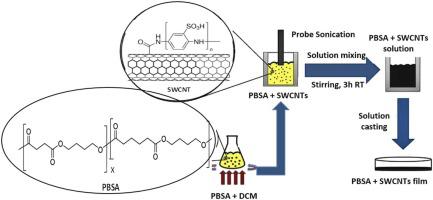当前位置:
X-MOL 学术
›
Ind. Crops Prod.
›
论文详情
Our official English website, www.x-mol.net, welcomes your feedback! (Note: you will need to create a separate account there.)
Machine learning algorithms to optimize the properties of bio-based poly(butylene succinate-co- butylene adipate) nanocomposites with carbon nanotubes
Industrial Crops and Products ( IF 5.6 ) Pub Date : 2024-06-25 , DOI: 10.1016/j.indcrop.2024.119018 Elizabeth Champa-Bujaico , Ana M. Díez-Pascual , Pilar Garcia-Diaz , Valentina Sessini , Marta E.G. Mosquera
Industrial Crops and Products ( IF 5.6 ) Pub Date : 2024-06-25 , DOI: 10.1016/j.indcrop.2024.119018 Elizabeth Champa-Bujaico , Ana M. Díez-Pascual , Pilar Garcia-Diaz , Valentina Sessini , Marta E.G. Mosquera

|
Poly[(butylene succinate)-co-adipate] (PBSA)-based materials are gathering much attention in the packaging industry, agriculture, and other fields owed to their biocompatibility and biodegradability. Nonetheless, poor thermal and mechanical properties of biodegradable polymers, such as PBSA, have hampered their wide-spread use. Herein, a simple, cost-effective and scalable solution to improve the mechanical properties of PBSA is reported by using functionalized single-walled carbon nanotubes (SWCNTs). Different SWCNT loadings have been incorporated in the PBSA matrix via simple solution casting, and the ultrasonication conditions have been optimized to attain a homogenous SWCNT dispersion. The nanocomposites have been characterized in detail by scanning electron microscopy (SEM), Infrared spectroscopy, thermogravimetric analysis (TGA), differential scanning calorimetry (DSC), tensile and impact strength tests. Unprecedented increments in stiffness were found at low nanotube loadings, ascribed to the outstanding reinforcing capability of the SWCNTs combined with their superior modulus and strong interfacial adhesion with the matrix via H-bonding, polar and CH-π interactions. Further, four machine learning (ML) algorithms, Polynomial Regression (PR), Support Vector Machines for Regression (SVR), Gradient Boosting (GB) and Artificial Neural Network (ANN), were applied to predict their mechanical properties. The algorithm´s performance was assessed using analytical parameters such as the coefficient of determination (R), the mean square error (MSE) and the mean absolute error (MAE). The developed models exhibited strong performance, achieving R values ranging from 0.69 to 0.99 across the evaluated properties. The results corroborate that even when the same prediction model is used, its performance varies depending on the physical property to be predicted. Thus, SVR, GB, PR, and ANN were found to be the most effective for estimating the Young’s modulus, tensile strength, elongation at break and impact strength, respectively. This research holds great potential for advancing the field of modelling the mechanical properties of polymeric nanocomposites and their practical applications in various industries such as food, pharmaceutical and biomedicine. The development of accurate models for predicting nanocomposite properties would cheapen, simplify and systematize their design and production processes, resulting in improved final products and more efficient development procedures.
中文翻译:

机器学习算法优化生物基碳纳米管聚(丁二酸丁二醇酯-己二酸丁二醇酯)纳米复合材料的性能
聚[(丁二酸丁二醇酯)-己二酸共聚物](PBSA)基材料因其生物相容性和生物降解性而在包装工业、农业等领域受到广泛关注。然而,PBSA 等可生物降解聚合物的热性能和机械性能较差,阻碍了其广泛使用。本文报道了一种简单、经济高效且可扩展的解决方案,通过使用功能化单壁碳纳米管 (SWCNT) 来提高 PBSA 的机械性能。通过简单的溶液浇铸将不同的单壁碳纳米管负载量纳入 PBSA 基质中,并且优化了超声处理条件以获得均匀的单壁碳纳米管分散体。通过扫描电子显微镜(SEM)、红外光谱、热重分析(TGA)、差示扫描量热法(DSC)、拉伸和冲击强度测试对纳米复合材料进行了详细表征。在低纳米管负载量下发现了前所未有的刚度增加,这归因于 SWCNT 出色的增强能力,加上其优异的模量以及通过氢键、极性和 CH-π 相互作用与基体的强界面粘附力。此外,还应用四种机器学习(ML)算法:多项式回归(PR)、回归支持向量机(SVR)、梯度提升(GB)和人工神经网络(ANN)来预测其机械性能。使用确定系数 (R)、均方误差 (MSE) 和平均绝对误差 (MAE) 等分析参数来评估算法的性能。开发的模型表现出强大的性能,在评估的属性中实现了 0.69 至 0.99 的 R 值。 结果证实,即使使用相同的预测模型,其性能也会根据要预测的物理特性而变化。因此,SVR、GB、PR 和 ANN 被认为是分别估算杨氏模量、拉伸强度、断裂伸长率和冲击强度最有效的方法。这项研究对于推进聚合物纳米复合材料机械性能建模领域及其在食品、制药和生物医学等各个行业的实际应用具有巨大潜力。开发用于预测纳米复合材料性能的精确模型将降低其设计和生产过程的成本、简化和系统化,从而改进最终产品并提高开发程序的效率。
更新日期:2024-06-25
中文翻译:

机器学习算法优化生物基碳纳米管聚(丁二酸丁二醇酯-己二酸丁二醇酯)纳米复合材料的性能
聚[(丁二酸丁二醇酯)-己二酸共聚物](PBSA)基材料因其生物相容性和生物降解性而在包装工业、农业等领域受到广泛关注。然而,PBSA 等可生物降解聚合物的热性能和机械性能较差,阻碍了其广泛使用。本文报道了一种简单、经济高效且可扩展的解决方案,通过使用功能化单壁碳纳米管 (SWCNT) 来提高 PBSA 的机械性能。通过简单的溶液浇铸将不同的单壁碳纳米管负载量纳入 PBSA 基质中,并且优化了超声处理条件以获得均匀的单壁碳纳米管分散体。通过扫描电子显微镜(SEM)、红外光谱、热重分析(TGA)、差示扫描量热法(DSC)、拉伸和冲击强度测试对纳米复合材料进行了详细表征。在低纳米管负载量下发现了前所未有的刚度增加,这归因于 SWCNT 出色的增强能力,加上其优异的模量以及通过氢键、极性和 CH-π 相互作用与基体的强界面粘附力。此外,还应用四种机器学习(ML)算法:多项式回归(PR)、回归支持向量机(SVR)、梯度提升(GB)和人工神经网络(ANN)来预测其机械性能。使用确定系数 (R)、均方误差 (MSE) 和平均绝对误差 (MAE) 等分析参数来评估算法的性能。开发的模型表现出强大的性能,在评估的属性中实现了 0.69 至 0.99 的 R 值。 结果证实,即使使用相同的预测模型,其性能也会根据要预测的物理特性而变化。因此,SVR、GB、PR 和 ANN 被认为是分别估算杨氏模量、拉伸强度、断裂伸长率和冲击强度最有效的方法。这项研究对于推进聚合物纳米复合材料机械性能建模领域及其在食品、制药和生物医学等各个行业的实际应用具有巨大潜力。开发用于预测纳米复合材料性能的精确模型将降低其设计和生产过程的成本、简化和系统化,从而改进最终产品并提高开发程序的效率。











































 京公网安备 11010802027423号
京公网安备 11010802027423号